Featured photo by Dark Rider on Unsplash
Beyond the Billboard music charts as the single industry standard of success, there is now a plethora of platform-specific music charts out today that guides music business operators today.
From streaming platforms like Spotify, Apple Music, YouTube and SoundCloud to download marketplaces like iTunes and Beatport to music discovery applications like Shazam, all showcase their own take on the latest and greatest in new (and sometimes old) music.
“Our YouTube audience doesn’t necessarily follow up on Spotify,” Daniel Lee, Label Manager at NCS, told me. “We see YouTube, Spotify and SoundCloud as serving three really distinct audience segments.” — via Cherie Hu’s Forbes article(Oct 2017)
Before you let the data overload overwhelm you, there’s a lot to gain in treating each platform with a unique approach. The days of a one-size-fits-all chart system have long passed: every smartphone owner has their favorite apps that they use on a daily basis, and just because an artist does an exclusive, the listener may or may not care enough to force a behavior change.
So by learning the nuances of each platform’s charts, you can discover how they can inform your daily business decisions, and be more creative in how you market your music, plan a summer tour or maybe who to collaborate with next in the studio.
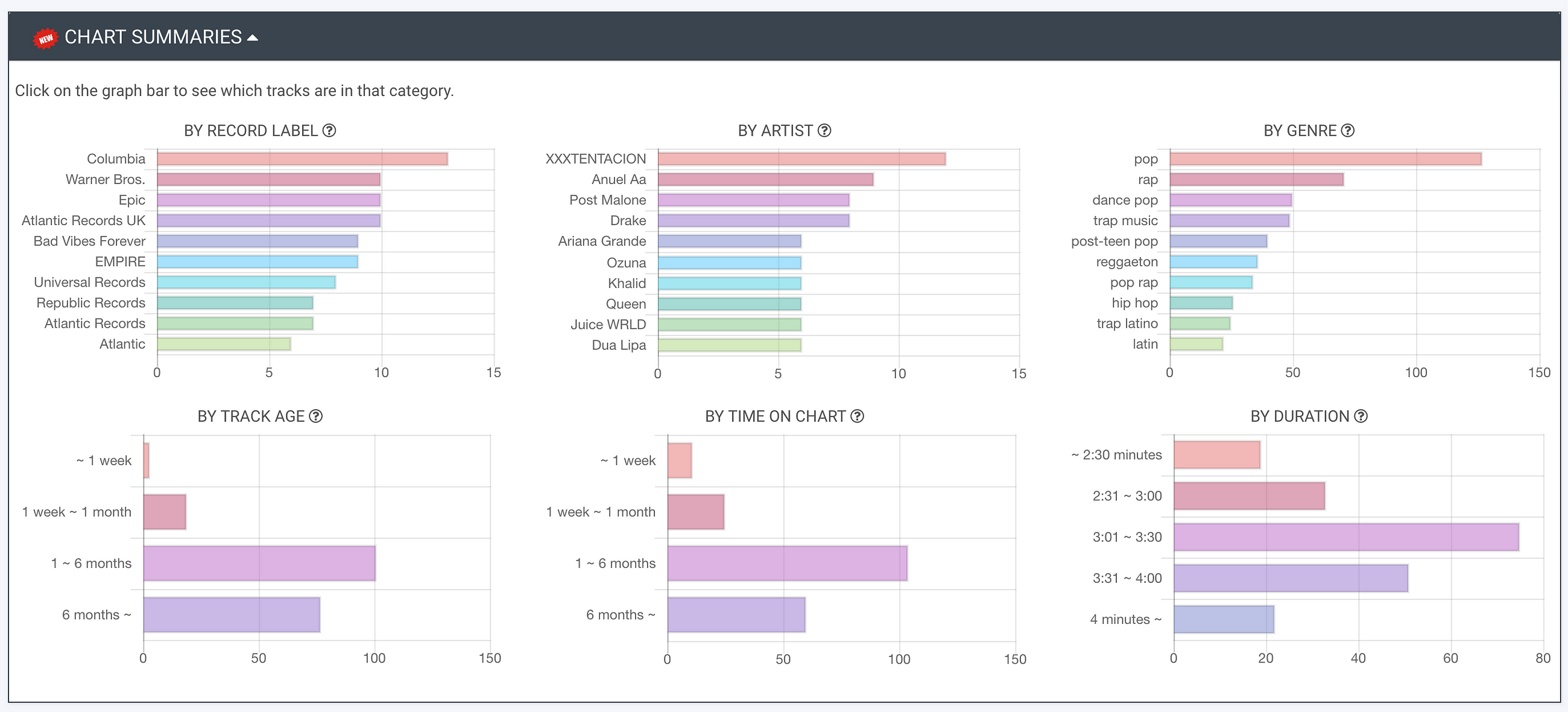
Chart Summaries
We’ve been working on a new feature called “Chart Summaries”- a way to boil down all of these charts to their DNA and user behavior dynamically. Choose the day, the week, the country, the genre…it’s all here.
Who’s on top? Which label is performing the best today? How about a week ago? A year? Do longer or shorter songs shine on this platform? Maybe this chart favors catalogue tracks, so I could put more effort into dusting off my old repertoire? If we push harder on this platform, maybe we could expect a longer playlist shelf life?
The way you decide to use the Chart Summaries (current users click here; new users sign up for a free account here) is up to you, but let’s take a 30,000-foot view to get acquainted.

// Spotify: Top 200 (Global)
Spotify refreshes a Top 200 chart every 24 hours, aggregating them every Thursday into a weekly view. While you can view in its various territories, a look into its Global chart reveals this:
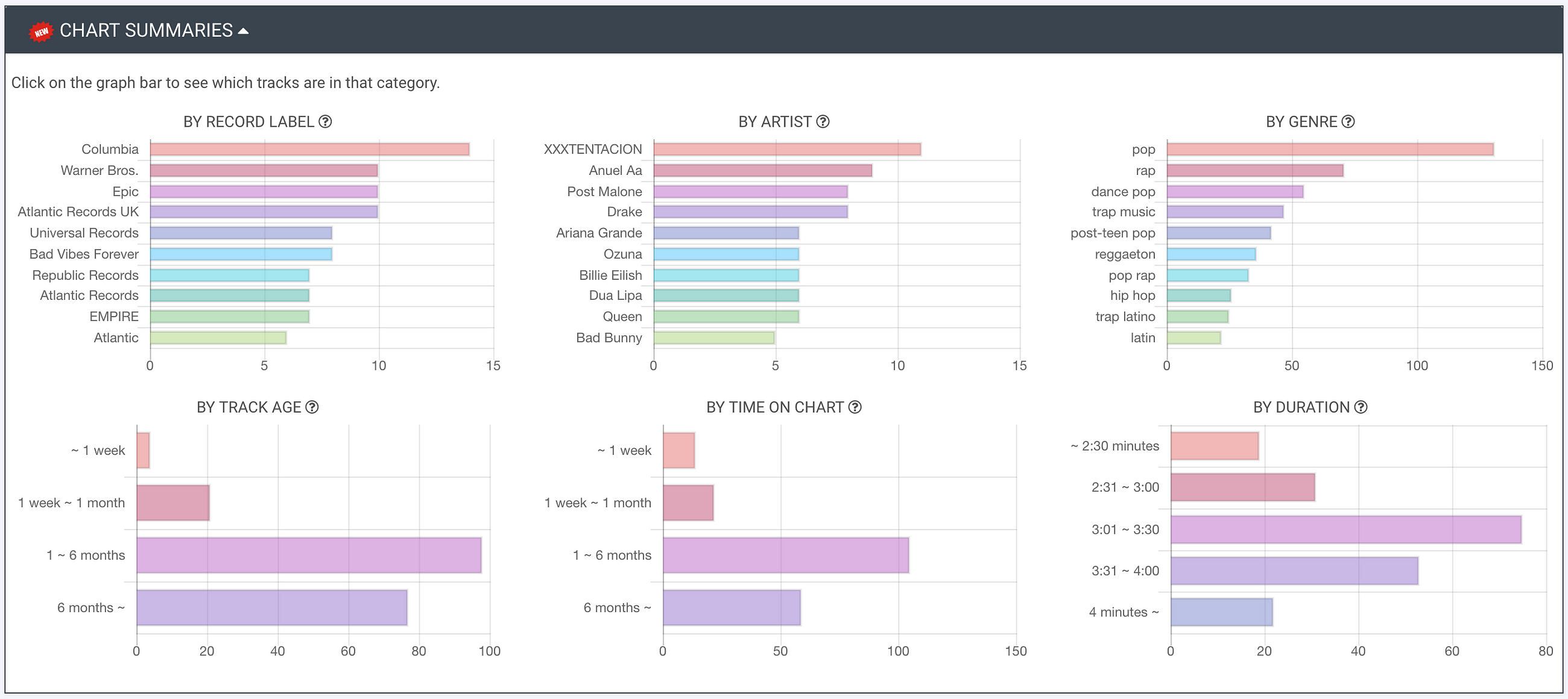
By record label, we see most of the major label imprints (such as Sony’s Columbia with 14 tracks) commanding the chart, and the top four artists (by track count) being rappers, including America’s Post Malone and the late XXXTENTACION, along with Canada’s Drake.
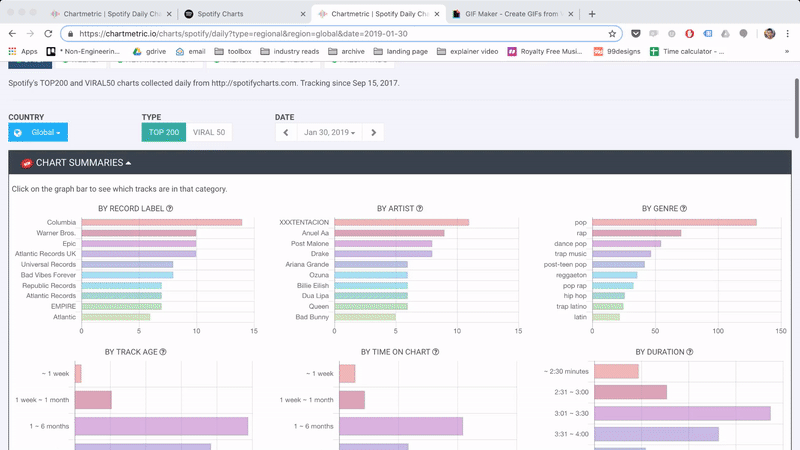
For those new to the Latin trap scene, Puerto Rico’s Anuel AA might be an unfamiliar name, but the trapeton vet shows up on Spotify’s Top 200 with a whopping nine tracks, including his most recent release “Secreto” with Colombia’s Karol G. In our Chart Summary, this places him in the #2 spot for artist with the most tracks on the Spotify chart.
This can all be found by clicking on any point of interest in the Chart Summary, and from the track details view, click through to an Artist Page (see GIF above).
// Spotify: Viral 50 (Global)
Switching to Spotify’s Viral 50 chart (global), we begin to see an expected trend that we’ll encounter in other platforms: the more “viral” or “trending” a certain chart is, the newer the tracks are. Makes sense at first glance, but when checking out Spotify’s Viral 50, they’re not necessarily new releases:
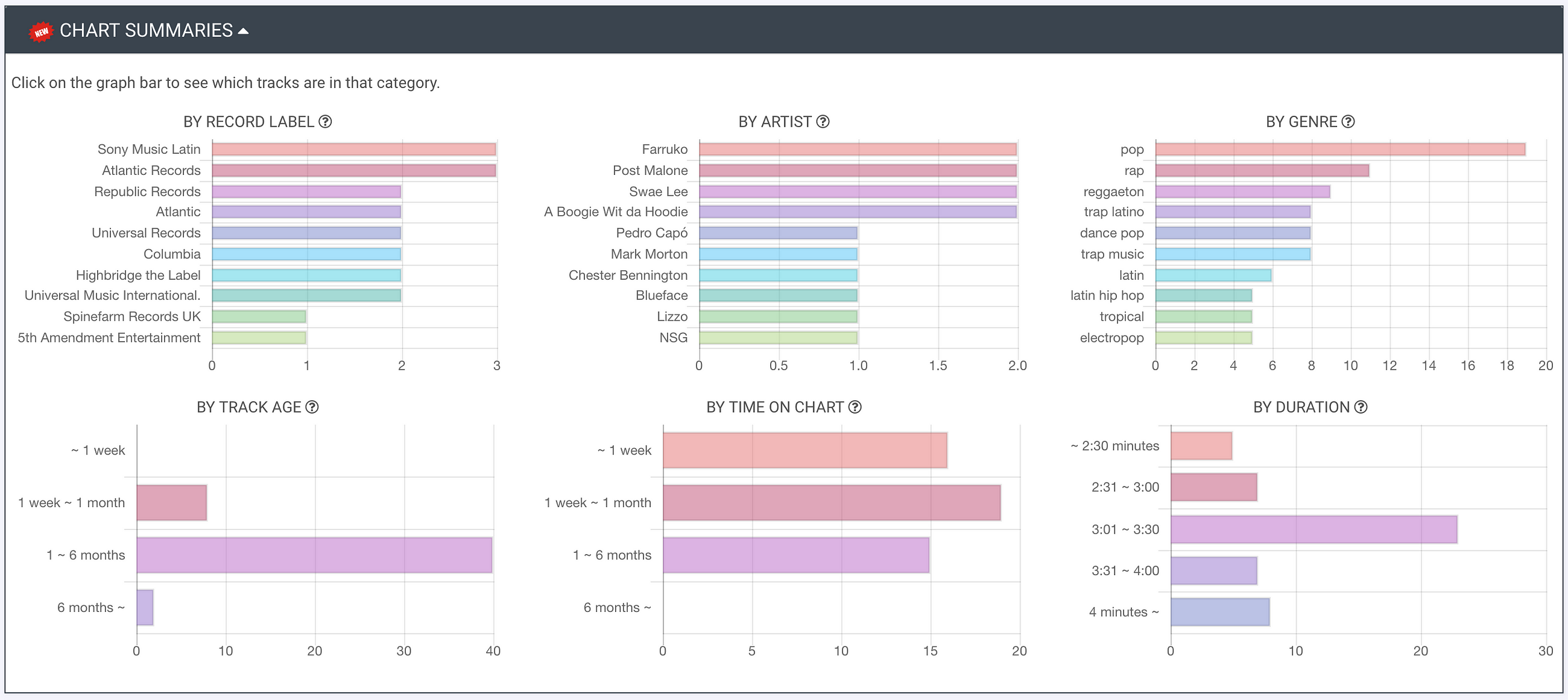
Forty of the Viral 50 are one to six months old, showing a slightly younger median track age than its Top 200 counterpart (78 of the Top 200 are beyond six months old). While how “viral” is defined by Spotify (or any platform) is less transparent, it’s likely to include major factors such as % increase in spin count, listen vs skip time, and % saves to libraries (or likes or “hearts”) in a given time period compared to other tracks.
There is a much more diverse artist set in the Spotify Viral 50 as well, with no artist having more than 2 tracks (4%) going viral, while in the Top 200 chart, the top four artists held 36 tracks (18%) of the positions.
Naturally, the Viral tracks are much more short-lived with no tracks staying for more than half a year, while the Top 200 tracks tend to grow some roots: 59 tracks languished for more than six months. Given that there are 40M+ tracks on the platform, it might be surprising that ~0.000001% of Spotify’s catalog is dominating ~30% of the Top 200 half of the year.
// Spotify: New Music Friday
With New Music Friday (NMF) playlists cementing Friday as the global focusof the music business week since 2015, our “New Music Friday” tab aggregates all of the tracks in NMF playlists to give you the world perspective that streaming deserves.
The resulting Chart Summary reveals a much more cosmopolitan point of view:
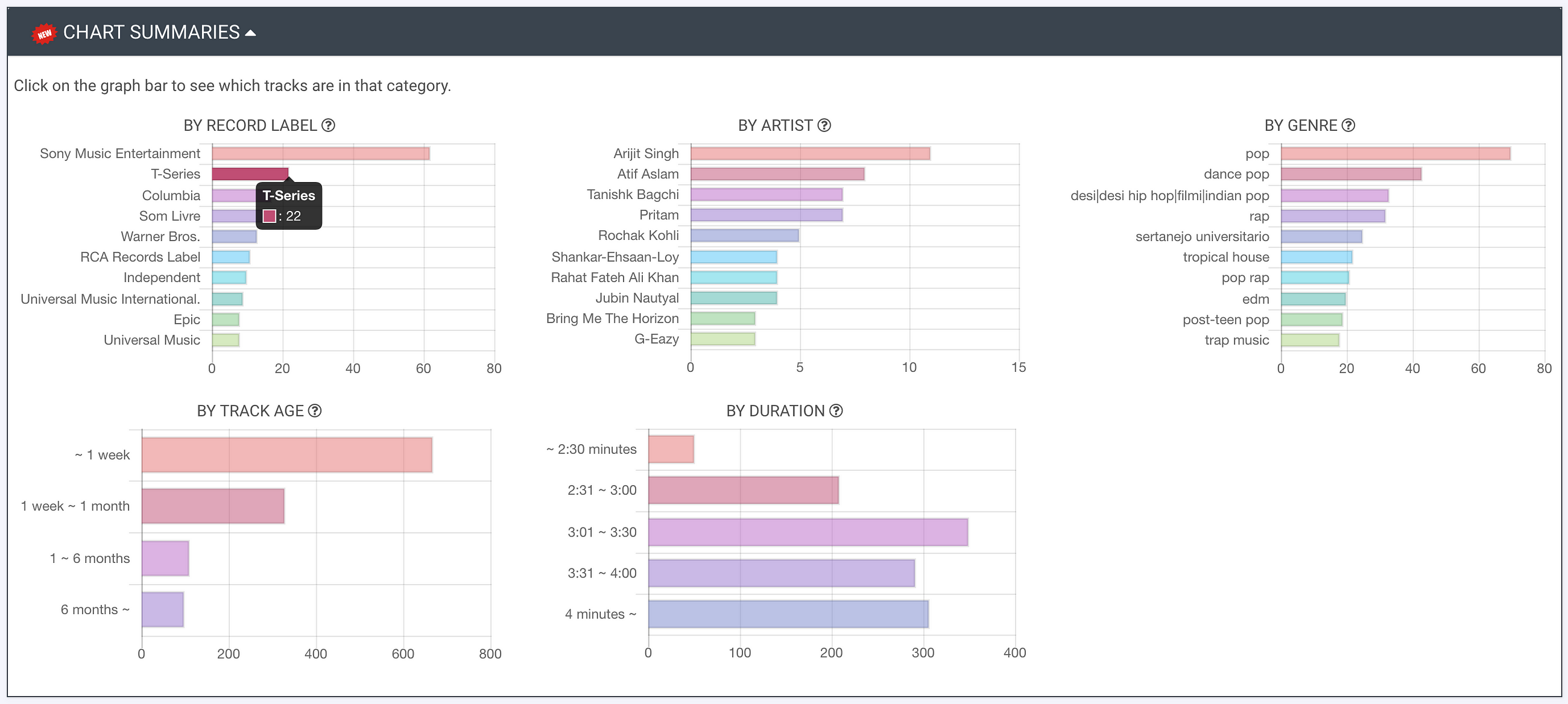
We speculate that NMF playlists are less overtly data-driven and more subject to label relationships and negotiations, so the results are that much more interesting.
The most eye-catching quality is the significant Desi presence, with YouTube’s #2 most subscribed channel T-Series having 22 of the NMF tracks in all of Spotify’s NMF playlists worldwide. India’s Arijit Singh (11 tracks) and Pakistan’s Atif Aslam (9 tracks) take the #1 and #2 spots with the most songs on all the NMF lists.
// Spotify: Trending on Playlists
The “Trending on Playlists” tab is a Top 200 chart that prioritizes tracks with the most playlist adds in the past month. The idea is to highlight platform-wide interest, without minimum playlist follower counts.
Not only does this chart include high-profile Spotify playlists, but also user-generated personal playlists or those only meant to be shared with a handful of friends. While these lower-end playlists may never be great spin-drivers, we believe it still shows an active level of engagement that’s higher than passively listening to a playlist and never knowing who sang any of the tracks.
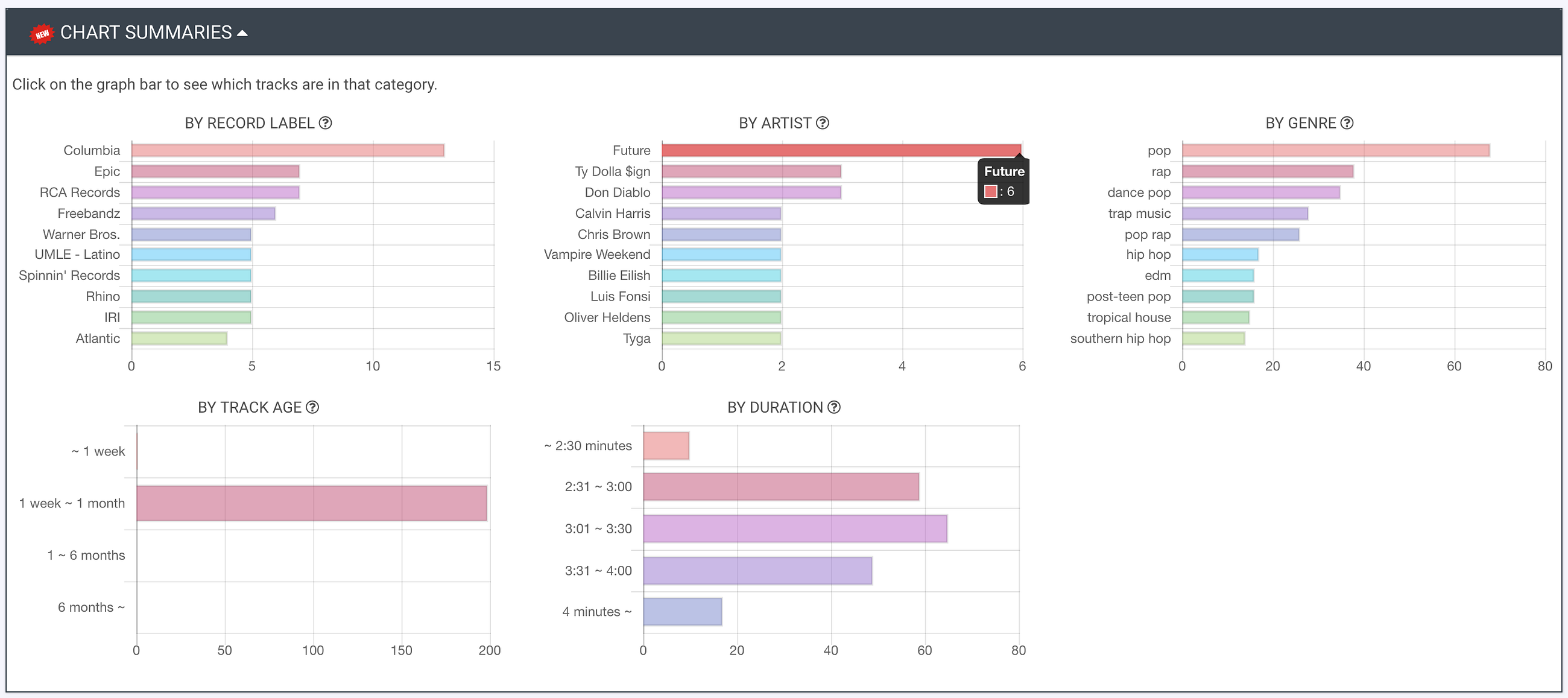
With a somewhat regular-looking label, duration and genre distribution, the most notable insight on February 1 is American rapper Future running the #1 spot with six tracks, fresh off his record-breaking release Future Hndrxx Presents: The WIZRD.
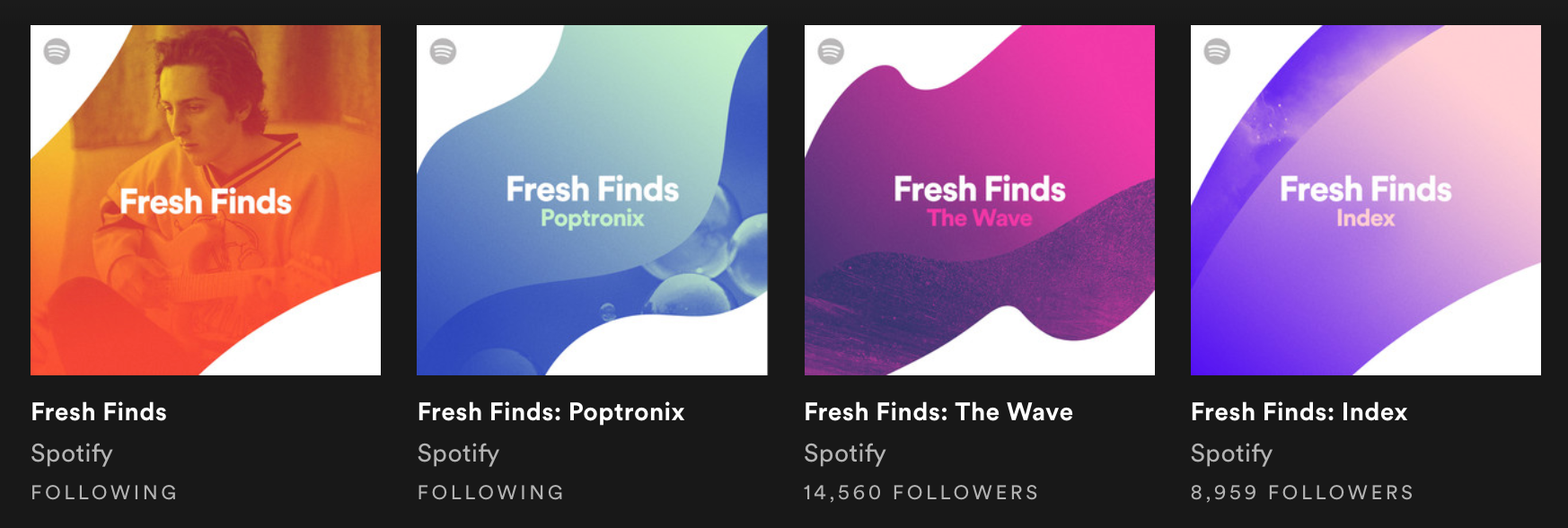

// Spotify: Fresh Finds
With Spotify’s non-personalized, human-curated playlist series “Fresh Finds”, the platform focuses on an (unknowingly) designated sample set of tastemakers that have consistently proven to show high listening activity on unknown tracks before they become popular.
We’ve aggregated all of the Fresh Finds playlist track contents here:
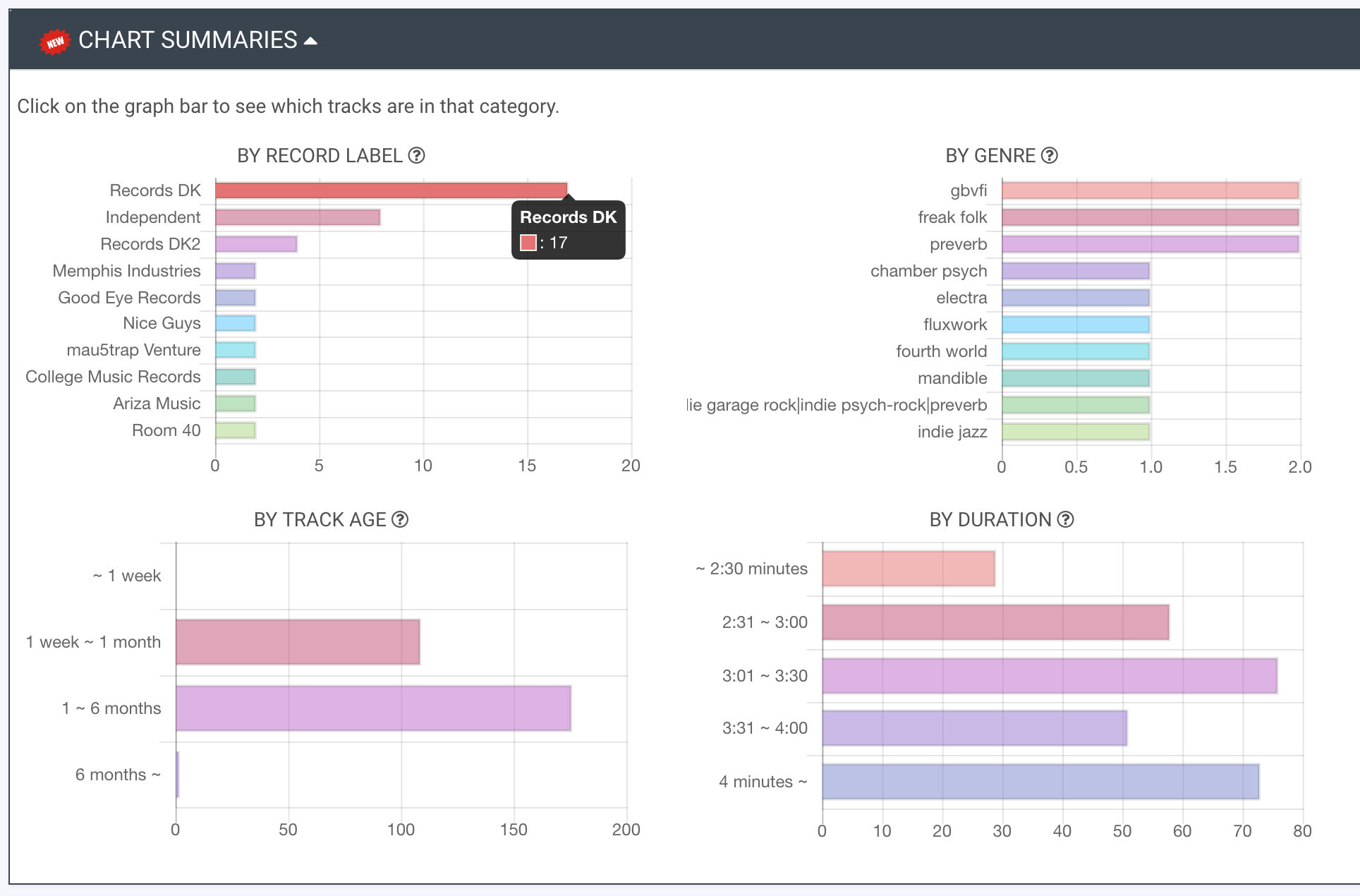
By far, Fresh Finds yields the most unconventional Chart Summary on Spotify. A quarter of the tracks (73 out of 287) have 4+ minute durations, which by Top 40 standards, is forever and defies streaming economics. Despite the near-300 count track list, no one genre is mentioned more than twice, with Echo-Nest-defined tags such as “gbvfi” and “chamber psych” peppering the repertoire.

Most notable is the record label section, in which DistroKid, the digital distribution platform available to independent artists around the world, commands the #1 spot with 21 tracks (“Records DK” [17] and “Records DK2” [4] are two of the default label fields). In Jan 2019, Spotify went so far as to name DistroKid as one of only three digital distributors that were “Preferred”, along with Sony’s The Orchard and CDBaby.
Whether this has anything to do with DistroKid-distributed artists showing up on Fresh Finds so prominently is unknown to us, but to Spotify’s credit, Fresh Finds succeeds in digging up new artists and sounds outside of the 0.000001% we previously saw in the Top 200 chart.

// Apple Music: Daily Top 100 (Global)
Apple Music provides a straight-forward Daily Top 100, and its Global version shows an overwhelmingly hip-hop-oriented list:

With over half of the Global Top 100 designated “Hip-Hop/Rap”, it sends a strong signal about the tastes of the Apple Music user base. Continuing his new album success cross-platform, Future takes advantage of this hip-hop preference with eight Top 100 tracks, seven of them from the new album.
This hip-hop-heavy insight is obviously informative for any artists in the rap game to pay attention to, and for those in other genres, it could serve as a “pass” in terms of playlist pitching resources or if up for a challenge, maybe an opportunity to stand out with.
// Apple Music: Tracks By Genres (United States / All Genres)
Closely related to the Daily Top 100, the Apple Music “Tracks By Genres” chart allows the same approach, but categorized by sound instead of geography.
As Apple Music localizes every user’s app to their country, there is no “global” option, but feel free to choose whichever territory you’re interested in.
Here is the United States Chart Summary for All Genres:
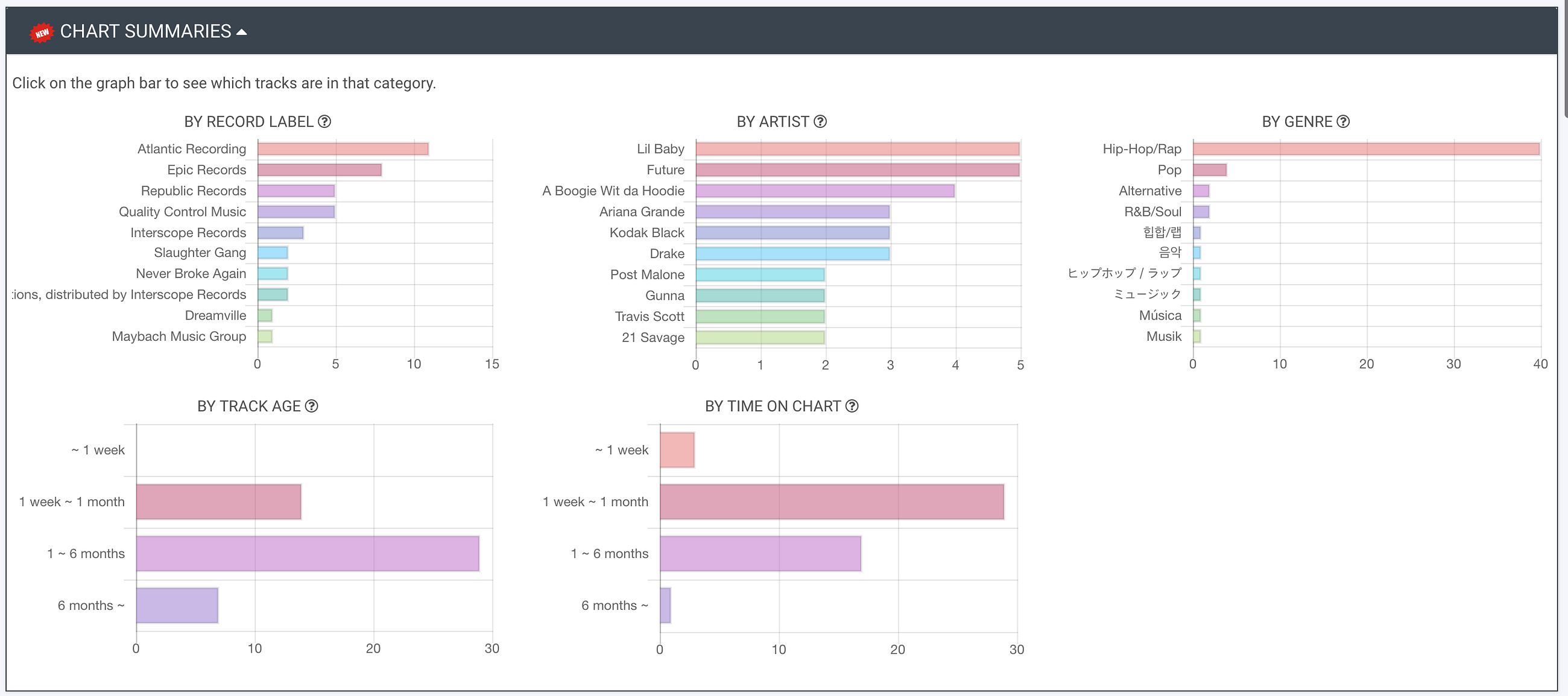
Though this specific chart is US-focused, we see mostly the same behavior as the Daily Top 100 (Global), which suggests a strong American influence to global Apple Music consumption.
What also sticks out most is a shorter median time on chart (58% of the tracks spend only one week to one month on it), compared to the 69% of the country-centric Daily Top 100 tracks spending 1–6 months on that chart.
This begs curiosity: once you take away socio-economic borders, does music becomes more fluid to audiences, and tracks change up more often in popularity? It’s worth a deeper look into the effects of country-specific marketing.
But overall, a cross-platform behavior seems to exist in which lucky artists with top hits on Spotify and Apple Music can expect to get great exposure (and royalty statements) for several months on a single, long after they’ve moved on to other songs. Both ecosystems tend to keep those same tracks in the spotlight.
“In general, most people are perfectly content with the most popular products.” — Harvard Business School’s Anita Elberse in “Blockbusters: Hit-making, Risk-taking, and the Big Business of Entertainment”
To be fair, this could very well simply be human behavior tending towards the popular. Harvard Business School’s Anita Elberse seems to agree that the “long tail”, while nice in theory, is simply not as a reliable of business model. People seem to just like the hits.
But whether the chicken or the egg comes first…is a complex topic for another day.
// Apple Music: Trending on Playlists
For Apple Music, we take the same Trending on Playlists approach, highlighting the tracks with the most playlist adds in the past month:

Puerto Rican crooner Luis Fonsi, fresh off his 9th album Vida, beats out Future on our Apple Music version of this chart with six of Fonsi’s Vida tracks making onto the most playlists, out of this chart’s top 200 tracks.
It’s unwise to extrapolate a trend from one day’s chart, but the presence of fellow Boricuas Daddy Yankee (3 tracks) and Ozuna (2 tracks) suggest that Apple Music curators are supporting Latin music quite well.
// iTunes: Tracks (US / All Genres)
On Jan 29 2019, the music world lost one of its legendary R&B artists when James Ingram, 66, passed away in Los Angeles.
iTunes, Apple’s digital download marketplace, still proves itself reactive to current news, despite the overwhelming tide streaming has taken over audiences today.
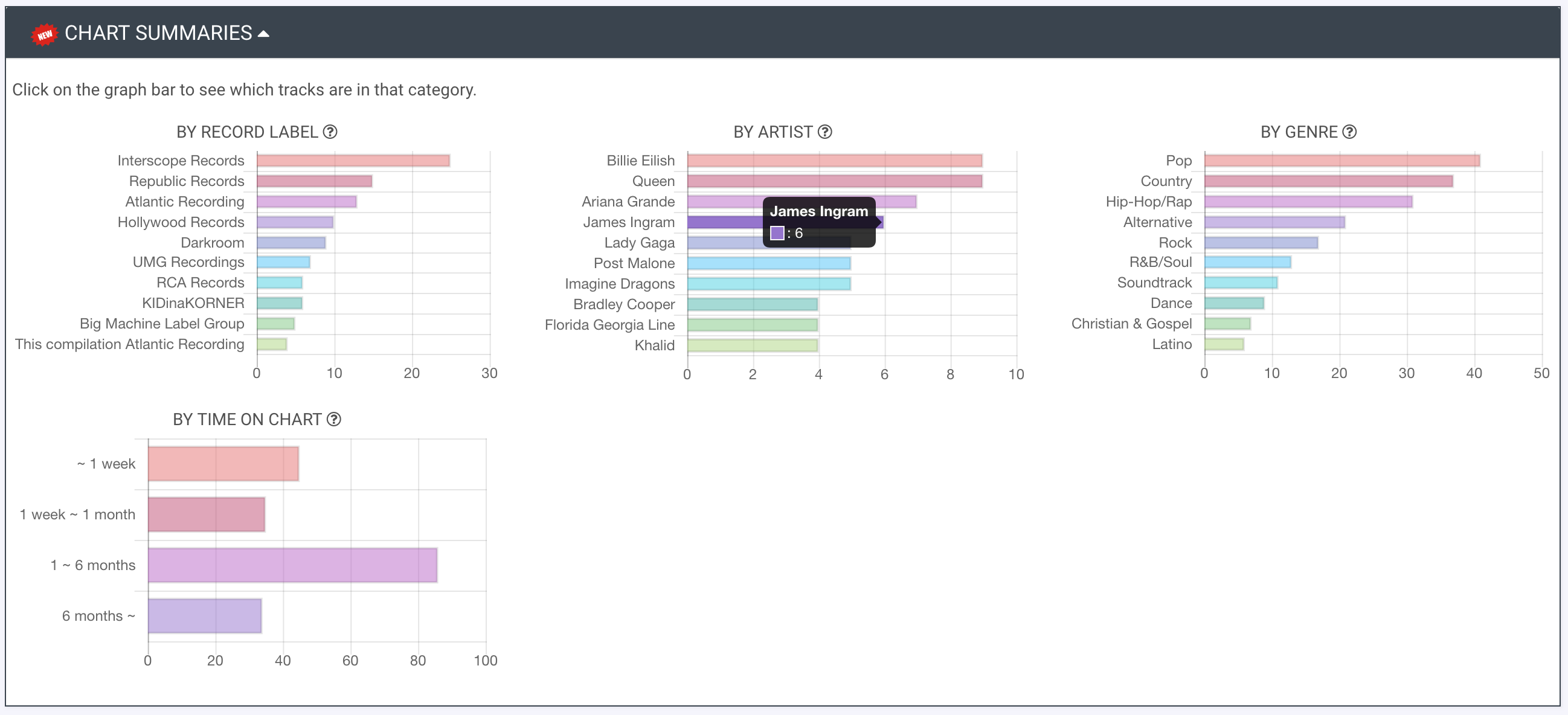
Most notable is James Ingram’s work making a very pronounced impact on the iTunes marketplace- not Apple Music’s- presumably due to the older demographic (preferring downloads over streaming) that is most familiar with his biggest hits in the 80s and 90s.

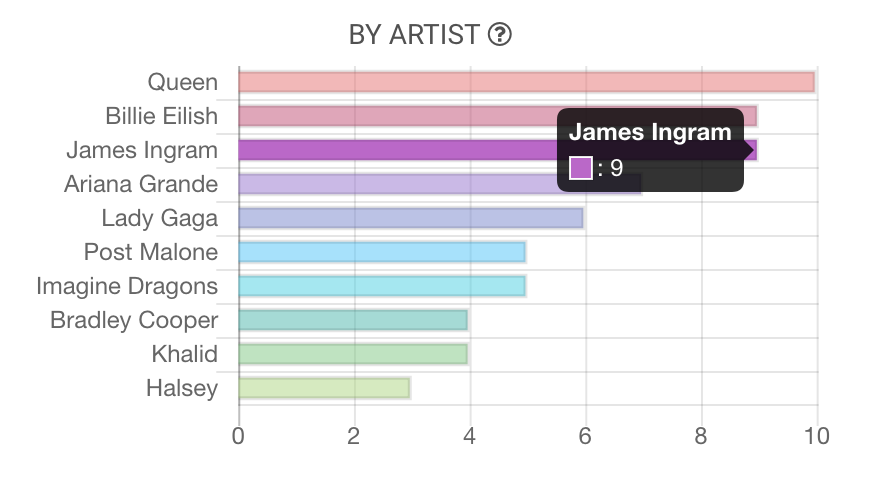
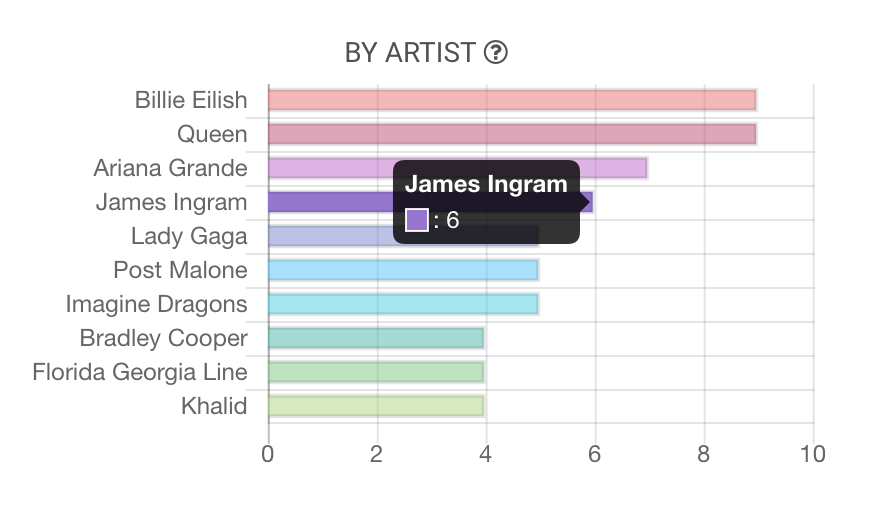
The day after his passing, Ingram topped this Chart Summary with 13 tracks, then to 9 and 6 respectively over the next two days. Another legacy act, Queen, maintains a high position as well, riding the long high of the “Bohemian Rhapsody” biopic released in Nov 2018, while dark pop artist Billie Eilish bucks this trend as a relatively young newcomer onto this iTunes chart. A stark aesthetic contrast to both Ingram and Queen, her visually-provoking content somehow seems to resonate even on the download charts.
// Shazam: Top 50 Tracks (City-level: Mexico City)
The music recognition app Shazam releases a top tracks chart that many in the industry view as a predictor of soon-to-be hits, due to its high-engagement nature. Shazam users, upon hearing a song in a bar, party or other space, take out their phone and “Shazam” the ambient noise so the app can identify and lead the user on to additional info.
While its Global Top 200 will surely be the first stop for most people, the city-level Shazam charts can provide a much more surgical tool to plan out social media campaigns or publicity runs.
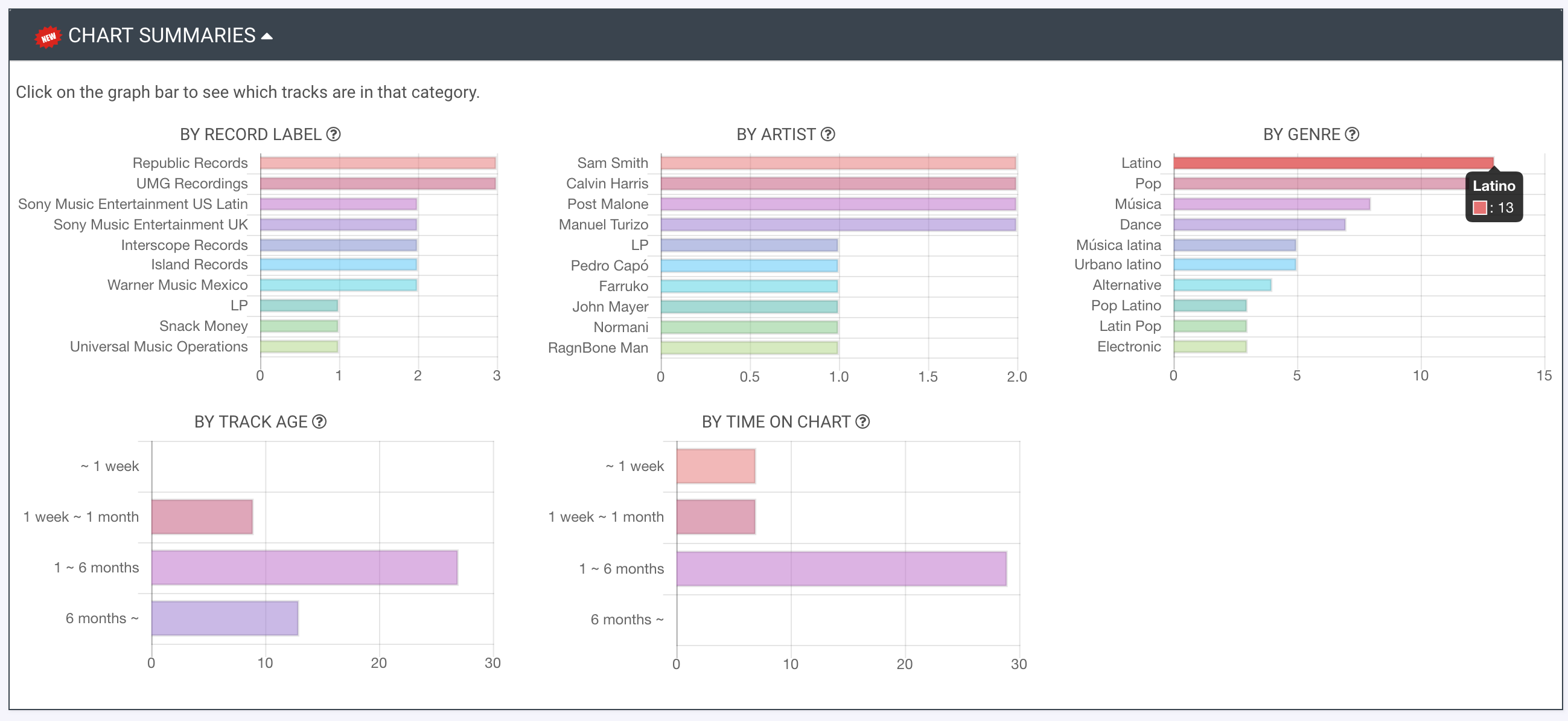
In Nov 2018, Spotify proclaimed Mexico City as the “World’s Music-Streaming Mecca”, so why not drill down via Shazam’s charts to see what music they’re curious about in the physical world?
It’s no surprise that 31 of the top 49 Shazam tracks are qualified as a form of Latin music. But its cosmopolitan list of favorite artists might: from UK’s Sam Smith and Normani to Colombia’s Manuel Turizo to Scotland’s Calvin Harris, there is no artist listed more than twice on Mexico City’s Shazam Top Tracks.
Spotify seems to have identified what many non-Latin-native industry players might not yet know: “Chilangos” (Mexico City residents) are to be viewed as world-class tastemakers. This well-distributed Shazam chart alone certainly can’t prove that, but first impressions sure don’t refute it.
// Beatport: Top 100 Tracks
Last but not least, Beatport continues to be a digital marketplace for the world’s professional DJs, a niche download B2B outlet that should definitely be thought of as separate from the B2C-oriented iTunes operation.

For those interested in keeping a pulse on the international club and remix scene- and potentially a foreshadowing for what sounds you may hear on the next Top 40 hit- Beatport charts are ones to watch.
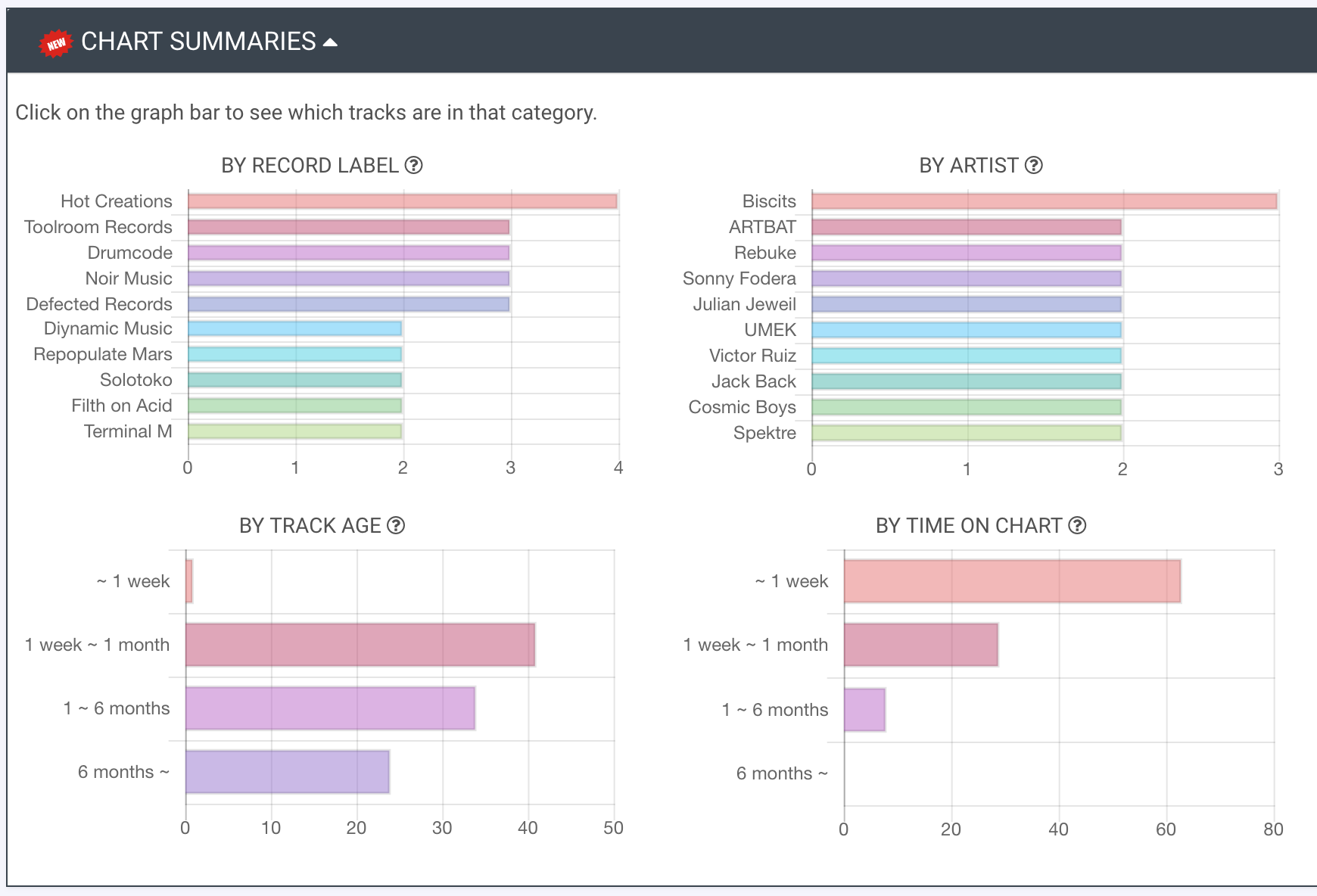
Just like Spotify’s Fresh Finds, Beatport’s “Top 100” list is a showcase of all the music outside of the mainstream spotlight you’re not seeing: there is no major label presence and the artist names are not household.
Regarding track age, Beatport shows a gently sloping curve after its max track count of 41 in the one week to one month category. With 34 (1–6 months) and 24 (6 months) tracks in the older bins, Beatport DJs show a healthy regard for relatively new music, but are always catching up with any tracks that might improve their club set, no matter how old they are.
This chart also shows a healthy refresh rate: 63% of the top 100 tracks spend less than a week on the Top 100, and absolutely zero that spend more than six months on it. Hence, Beatport DJs show a behavior which is the polar opposite of Apple Music and Spotify charts: out with the old, and in with the new.
Hopefully, this has been a useful first look at Chartmetric’s new Chart Summaries feature. We’re quite excited to simplify what is quite difficult: multiple platforms publishing daily charts in different territories with different genres. It’s simply too much for a pair of human eyes to digest…so that’s why we’re doing it for you 🙂
Side note: You’ll notice that our YouTube and SoundCloud charts do not currently feature Chart Summaries- this is due to cross-platform linking issues that are a work in progress!
If you have any questions in the meantime, please feel free to contact us at hi (at) chartmetric (dot) io, or go to help.chartmetric.io to chat with us in real-time during business hours, Pacific Standard Time.









